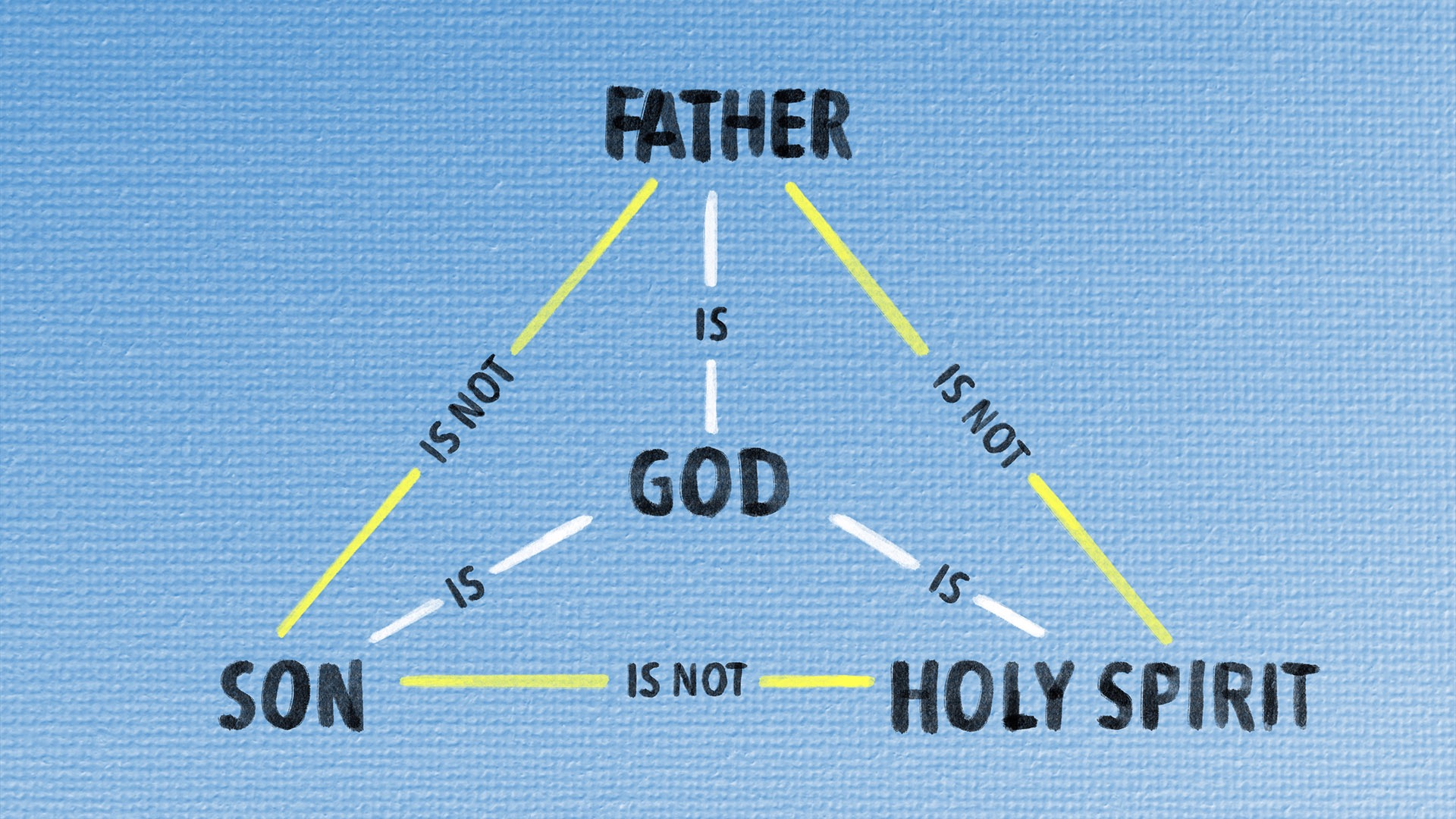✝️ The Mystery and Majesty of the Trinity: A Christian Explanation
🧭 What Is the Trinity?
The Trinity is one of the most beautiful—and mysterious—truths in all of Christian theology. In short, the doctrine of the Trinity teaches that there is one God who exists eternally in three persons: the Father, the Son (Jesus Christ), and the Holy Spirit.
This doesn’t mean Christians believe in three gods. Christianity is firmly monotheistic. But unlike other monotheistic religions, Christianity proclaims that the one God is tri-personal—three distinct persons sharing the same divine nature.
As the Athanasian Creed states:
“We worship one God in Trinity, and Trinity in Unity; neither confounding the persons nor dividing the substance.”
📖 The Trinity in the Bible
Though the word Trinity never appears in Scripture, the concept is woven throughout the biblical narrative.
Old Testament Hints
- Genesis 1:26 – “Let us make man in our image…” (plural language hints at plurality within God).
- Isaiah 48:16 – “The Lord God has sent Me, and His Spirit.” (three persons identified: the Lord, Me [the Servant/Messiah], and the Spirit).
While not fully revealed, the Old Testament plants seeds that bloom in the New.
New Testament Clarity
- Matthew 3:16–17 – At Jesus’ baptism, we see:
- The Father’s voice from heaven
- The Son in the water
- The Spirit descending like a dove
- John 14:16–17 – Jesus promises to send another Helper, the Holy Spirit, showing distinct roles and unity.
- Matthew 28:19 – Jesus commands His followers to baptize “in the name of the Father, and of the Son, and of the Holy Spirit.”
These passages show that God is one in essence, but revealed in three persons, interacting in relationship with one another.
🧱 The Doctrine Defined: One Essence, Three Persons
Essence means what God is—His divine being.
Person refers to the individual distinctions—Father, Son, and Spirit—who are not interchangeable, but are each fully God.
| Attribute | Father | Son (Jesus) | Holy Spirit |
|---|---|---|---|
| Fully God | ✔️ | ✔️ | ✔️ |
| Distinct Person | ✔️ | ✔️ | ✔️ |
| Eternal | ✔️ | ✔️ | ✔️ |
| Relational Role | Origin, Source | Redeemer, Word | Comforter, Guide |
🏛️ The Historical Journey of the Trinity
The church did not invent the Trinity but clarified and defended it as heresies arose.
Early Defenders of the Faith
- Tertullian (ca. 200 AD) was the first to use the term Trinitas in Latin. He spoke of “one substance, three persons.”
- Athanasius battled against Arianism, which denied Jesus’ full divinity, insisting that “the Son is of the same essence (homoousios) as the Father.”
Creeds and Councils
- Council of Nicaea (325 AD): Affirmed the full divinity of Christ.
- Council of Constantinople (381 AD): Clarified the divinity of the Holy Spirit.
- Athanasian Creed (5th century): A detailed affirmation of the Trinity used in liturgical settings.
These theological battles helped Christians define what they already believed based on Scripture and worship.
🧠 Tackling the Mystery: Analogies (and Their Limits)
The Trinity is not a contradiction but a mystery that transcends human categories.
Common Analogies
- Water: One substance—solid, liquid, vapor. (Can suggest modalism, where God just switches modes.)
- Sun: Star, light, and heat. (Helpful for understanding distinct roles, but fails to express personhood.)
- Human roles: One man as father, son, and husband. (Fails to show three co-existing persons.)
No analogy is perfect. If one could explain God completely, He wouldn’t be God.
As C.S. Lewis put it:
“If Christianity were something we were making up, of course we could make it easier. But it is not.”
🙏 Why the Trinity Matters
The Trinity isn’t just theology for seminary students—it touches every part of Christian life and salvation.
1. Salvation Is Trinitarian
- The Father planned our salvation (Ephesians 1:3–6)
- The Son accomplished it on the cross (Ephesians 1:7–12)
- The Holy Spirit applies it to us (Ephesians 1:13–14)
Your redemption is the work of all three persons of the Godhead—working in harmony.
2. Prayer Reflects the Trinity
Christians typically pray to the Father, in the name of the Son, and through the power of the Holy Spirit (Romans 8:26; Hebrews 4:16).
3. Community Reflects the Trinity
Just as the three persons of the Trinity live in eternal love and unity, we are called to love and live in unity (John 17:21–23). The Trinity becomes a model for the church.
❤️ The Trinity Reveals a Relational God
Many people think of God as a distant, impersonal force. But the Trinity shows us a God who is:
- Relational – Within Himself, God is a community of love.
- Personal – We can know each person of the Trinity intimately.
- Loving – Love is not something God does—it’s who He is (1 John 4:8).
Tim Keller once said:
“If God is unipersonal, then love is something that God must learn or create. But if God is tri-personal, then love is at the core of His being from all eternity.”
The Trinity teaches us that God didn’t create us because He was lonely—He created us to invite us into His joy.
🕊️ Illustrations: A Glimpse into the Divine
Sometimes art, music, and imagery help us sense what words cannot fully describe.
Visual Representations
- Triquetra – An ancient Celtic symbol with three interwoven loops.
- The Shield of the Trinity (Scutum Fidei) – A medieval diagram showing the relationships: The Father is God. The Son is God. The Spirit is God. The Father is not the Son…
Theological Art
- Andrei Rublev’s Icon (15th century): A famous Russian Orthodox icon showing three angelic figures seated at a table, symbolizing Genesis 18—but also representing the Father, Son, and Spirit in perfect harmony.
🧭 How to Explain the Trinity Simply
While the Trinity can’t be reduced to a slogan, here’s a simple way to explain it:
“God is one what (essence), and three whos (persons). Each person is fully God, not a part of God, and they exist in eternal, loving relationship.”
🔥 Common Misunderstandings and Heresies
- Modalism – God is one person who changes forms (like actor playing different roles).
- Tritheism – Belief in three separate gods.
- Arianism – Jesus is created and not fully divine.
All these distort the unity or equality within the Trinity. The early church wisely guarded the biblical balance: unity of essence, distinction of persons.
🛡️ Defending the Doctrine
When questioned, Christians can confidently say:
- The Trinity does not contradict reason, but surpasses it.
- It is not unbiblical, but is the natural outcome of a faithful reading of Scripture.
- It is not optional theology—it defines who the Christian God is.
As theologian Wayne Grudem explains:
“The doctrine of the Trinity is essential to our understanding of the Christian faith because it shows how God is both absolutely one and yet eternally in loving relationship.”
📚 References for Further Study
- Scripture: Matthew 28:19, John 1:1–14, Ephesians 1:3–14, 1 John 4:8
- Books:
- Delighting in the Trinity by Michael Reeves
- The Trinity by R.C. Sproul
- Systematic Theology by Wayne Grudem
- Creeds:
- Nicene Creed (325)
- Athanasian Creed (5th century)
🌄 Final Thoughts: Worshiping the Triune God
The Trinity is not just a doctrine to believe—it’s a truth to worship. It shows us a God who is both majestic and intimate. A God who saves us, indwells us, and invites us into His eternal joy.
The Father loves you.
The Son died for you.
The Spirit lives in you.
So when we say, “In the name of the Father, and of the Son, and of the Holy Spirit,” we are not speaking formulaic words—we are entering into the mystery of divine fellowship.
And that, dear friend, is very good news.
📝 Published by Mountain Veteran Ministries
💬 Leave a comment below or share this blog if it stirred your heart.
📧 Subscribe to our newsletter for more gospel-rooted insights.

